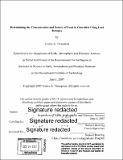Determining the concentration and source of lead in chocolate using lead isotopes
Author(s)
Thompson, Jessica Ann
DownloadFull printable version (10.93Mb)
Other Contributors
Massachusetts Institute of Technology. Department of Earth, Atmospheric, and Planetary Sciences.
Advisor
Samuel Bowring.
Terms of use
Metadata
Show full item recordAbstract
Single-origin dark chocolate samples derived from cocoa grown in developing countries from around the world were analyzed to determine their lead concentrations and the isotopic composition of the lead. The lead isotope ratios were compared with published data from aerosols and volcanic rocks nearest to the cocoa growing regions. Samples from different countries and manufacturers were compared, and we conclude that the source of lead depends on the country of origin and not the manufacturer. Chocolates grown in the Northern Hemisphere usually had lead isotope ratios that matched the global atmospheric lead isotopic signature from the Northern Hemisphere. Chocolates grown in the Southern Hemisphere did not match the global signature, but rather more closely matched the lead isotopic signature from volcanic rocks in their respective countries, and had a lower average lead concentration than chocolates from the Northern Hemisphere. Soils from Venezuela were also analyzed, and confirmed the conclusion that atmospheric lead is the predominant source of bioavailable lead. Many of the chocolates also had lead concentrations below the limit of 0.1 ppm set by the FDA; however, one manufacturer, Dagoba, consistently had lead concentrations above the limit. The percent of cocoa in each chocolate bar was also compared with the lead concentrations, concluding that the concentration of lead is not necessarily dependent on the amount of cocoa in the bar.
Description
Thesis: S.B., Massachusetts Institute of Technology, Department of Earth, Atmospheric, and Planetary Sciences, 2007. Cataloged from PDF version of thesis. Pages 81 and 87 missing from original thesis. Includes bibliographical references (pages 86-91).
Date issued
2007Department
Massachusetts Institute of Technology. Department of Earth, Atmospheric, and Planetary SciencesPublisher
Massachusetts Institute of Technology
Keywords
Earth, Atmospheric, and Planetary Sciences.